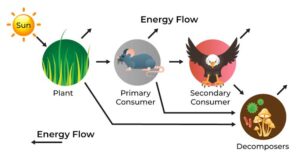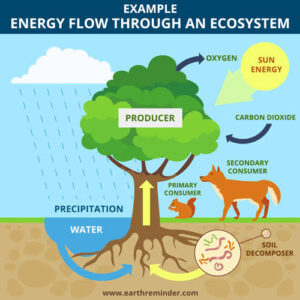Back to: Environmental Biology 100 Level
Welcome to class!
Hello amazing learner! It’s great to have you here again. Today’s lesson is very interesting because it explains how energy moves through living things in nature. Our topic is Energy Flow in Ecosystems, and by the time we finish, you’ll understand why the sun is the ultimate source of life on Earth. Let’s begin!
Energy Flow In Ecosystems
Have you ever thought about where the energy in your favourite meal of jollof rice comes from? It all starts from the sun! The energy that keeps you alive passes through plants, animals, and even tiny organisms before it gets to you. This movement of energy through the living parts of nature is what we call energy flow in ecosystems.

What is Energy Flow?
Energy flow is the movement of energy from the sun to plants and then to animals and other organisms in an ecosystem. Energy cannot be recycled, so it moves in one direction—from the sun through producers to consumers and finally to decomposers.
The Sun as the Main Source of Energy
The sun is the primary source of energy for almost all life on Earth. Plants capture sunlight through a process called photosynthesis and use it to make food. These plants become food for herbivores (plant eaters), and then carnivores (meat eaters) feed on the herbivores.

How Energy Flows in an Ecosystem
Energy in ecosystems flows in steps called trophic levels:
Producers: Plants and algae that make their own food using sunlight. Example: maize plants on a farm in Nigeria.
Primary Consumers: Herbivores that feed on plants. Example: goats, grasshoppers.
Secondary Consumers: Small carnivores that eat herbivores. Example: frogs, lizards.
Tertiary Consumers: Top carnivores that eat other animals. Example: lions, hawks.
Decomposers: Organisms like fungi and bacteria that break down dead plants and animals into nutrients for the soil.
Each level in this chain receives less energy than the previous one because some energy is lost as heat during life processes like breathing and movement. This explains why top predators are fewer in number than plants or herbivores.
Energy Flow through Food Chains and Food Webs
Energy moves through food chains (a single path of energy transfer) and food webs (a network of interconnected food chains). For example, in a Nigerian savanna:
Sun → Grass → Antelope → Lion
Importance of Energy Flow
It explains how life is supported in ecosystems.

It helps us understand why plants are more abundant than animals.
It shows why conserving energy and natural resources is important for life balance.
Summary
Energy flow in ecosystems starts from the sun, moves to producers, then to consumers, and finally to decomposers. Energy decreases at each level and cannot be recycled, which is why ecosystems need a constant supply of solar energy.
Evaluation
- What is the main source of energy for life on Earth?
- List the five main trophic levels in energy flow.
- Why does energy decrease at each trophic level?
You’ve done excellently well! Remember, understanding energy flow helps us protect the natural balance of life. Keep learning with Afrilearn—you’re building the knowledge to make a real difference in the world. See you in the next lesson!
